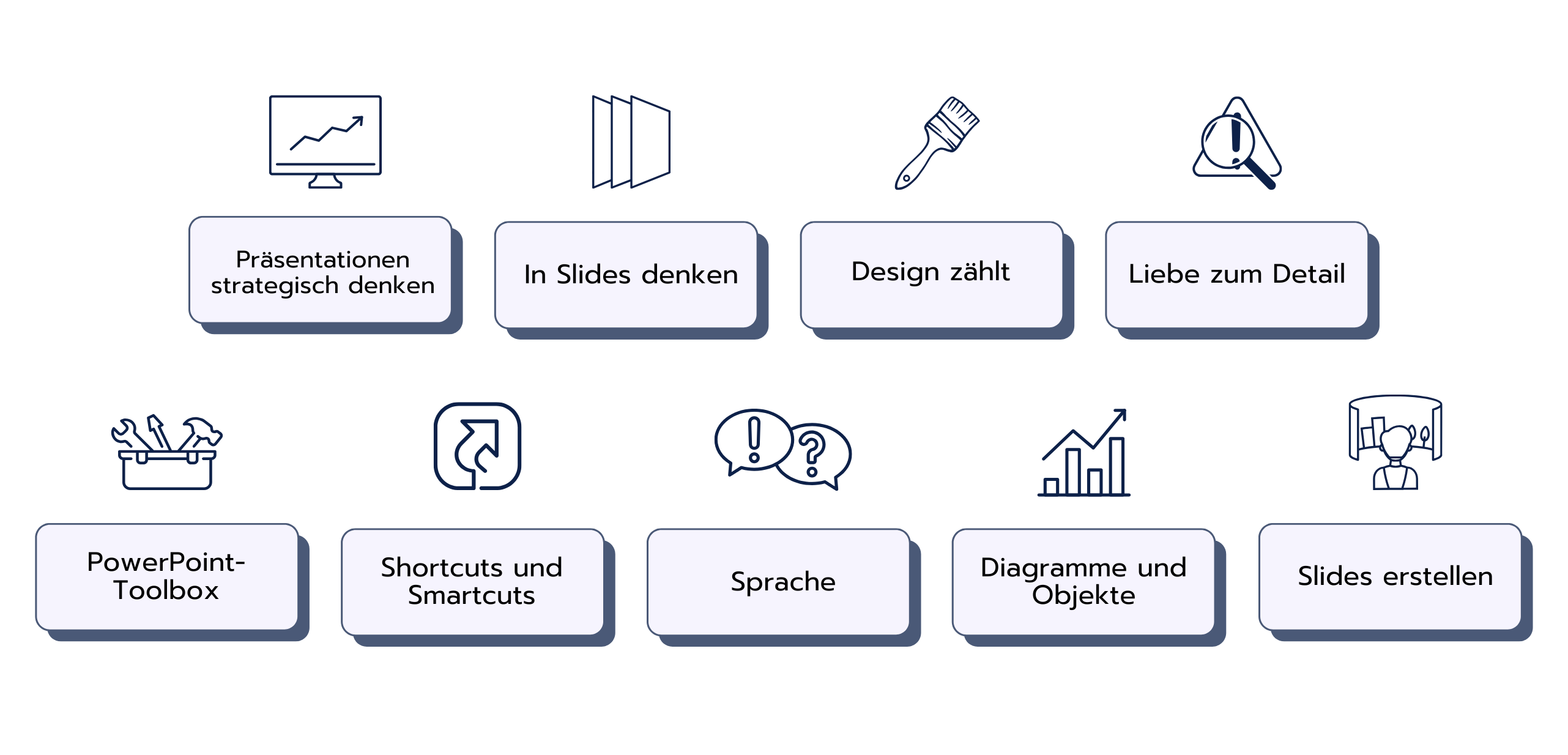In Slides denken
Sobald du deine Storyline und das Skeleton Deck erstellt hast, geht es an die Ausarbeitung der Slides. Dafür brauchst du eine Fähigkeit, die ich „In Slides denken“ nenne. Darüber wird selten gesprochen, aber sie ist extrem wichtig. Manche sind ein Naturtalent, aber die meisten müssen sich das Schritt für Schritt erarbeiten.
Um in Slides zu denken, musst du deine Gedanken so strukturieren, dass sie auf einer PowerPoint-Folie funktionieren. Ein Dokument liest man von oben nach unten, aber eine Folie ist komplexer und bietet viel mehr Möglichkeiten: Slide-Titel, Fließtext, Bilder, Grafiken, Pfeildiagramme, Funnels, Tabellen, Harvey Balls, Heatmap-Tabellen … die Liste ist lang.
Das richtige Slide-Konzept hilft dir, deine Botschaft klar und effektiv zu vermitteln. Eine gute Folie sollte für Außenstehende in wenigen Sekunden verständlich sein, denn oft ist genau das die Aufmerksamkeitsspanne von Klient:innen oder Partner:innen.
Design zählt
Beim Erstellen von Slides spielt das Design eine zentrale Rolle. Gute Consultants wissen: Folien müssen mindestens ordentlich, idealerweise aber ansprechend aussehen. Für interne Präsentationen sind einfache und schlichte Folien in Ordnung. Beim Kunden solltest du aber mehr Sorgfalt investieren. Achte auf Designelemente wie Positionierung von Textboxen, Abstände zwischen Elementen, sinnvoller Einsatz von Weißraum, einheitliche Formatierung über alle Slides hinweg, richtige Schriftgrößen, Bildformate und Seitenverhältnisse, etc.
Deine Folien sollten immer professionell und einheitlich aussehen.
Nicht überladen, unstrukturiert, planlos, schwer verständlich oder (im schlimmsten Fall) hässlich.
Liebe zum Detail
Diese Fähigkeit steht in fast jeder Stellenausschreibung und wird trotzdem oft unterschätzt. Es geht um Genauigkeit auf mehreren Ebenen: Sprache, Design & Formatierung, inhaltliches Konzept und Datenqualität.
Hast du auf sprachliche Details geachtet? Stimmen Rechtschreibung, Grammatik und Zeichensetzung? Gibt es Tippfehler, doppelte Leerzeichen oder uneinheitliche Schreibweisen? All das ist wichtig.
Wie sieht es mit Design & Formatierung aus? Sind alle Elemente einheitlich ausgerichtet und formatiert? Sind Abstände, Einzüge und Ränder aufeinander abgestimmt? Dies gewährleistet ein ordentliches Aussehen.
Machst du dir Gedanken über konzeptionelle Details? Vermitteln deine Slides wirklich die beabsichtigte Aussage? Gibt es Abweichungen von der Storyline oder dem Seitenkonzept? Gibt es zu viele Daten auf dem Slide oder ist die abgebildete Analyse zu oberflächlich?
Hast du die Informationen im Detail geprüft? Sind alle Zahlen korrekt? Stimmen die Empfehlungen? Sind Quellen sauber in den Fußnoten angegeben? Wurden dort alle Abkürzungen erklärt? Haben die Grafiken die richtigen Achsen und Legenden?
Manager:innen und Partner:innen sehen solche Fehler sofort und mögen sie gar nicht. Wenn dir das öfter passiert, wirst du in deiner Performance Review in Bezug auf Verbesserungspotenzial garantiert darauf angesprochen.
PowerPoint-Toolbox
Die PowerPoint-Toolbox ist wie ein Satz Küchenmesser: Du musst damit umgehen können, um die Basics zu beherrschen. Die meisten Tools findest du im Ribbon (Menüleiste oben). Es lohnt sich, dort einfach mal durchzuklicken und mit der Maus über die Buttons zu fahren, um ihre Funktion zu verstehen. Wenn dir etwas unklar ist: Eine schnelle Google-Suche reicht meistens schon aus, es gibt mehr als genug Online-Hilfen.
Ein formeller Kurs zur Erklärung der Toolbox ist in der Regel nicht nötig. PowerPoint ist sehr praxisorientiert und du lernst am besten durch Ausprobieren und Nachbilden.
Starte mit den wichtigsten Tabs im Menüband:
- Start
- Einfügen
- Zeichnen
- Entwurf
- Überprüfen
- Ansicht
- usw.
Mach dich mit grundlegenden Tools vertraut, wie z.B. Schriftarten und -größen, Absatzformatierung, Abstände, Formen, Füllungen und Rahmen. Es gibt viel zu entdecken, also probier es aus und lerne.
Schaue dir auch die etwas fortgeschritteneren Funktionen an, wie z. B. Folienmaster, Notizen, Präsentationsansicht und Abschnitte. Diese helfen dir vor allem bei größeren Präsentationen, den Überblick zu behalten.
Shortcuts und Smartcuts
Du kennst jetzt die grundlegenden Tools und beherrschst auch die fortgeschrittenen Funktionen. Jetzt geht es darum, schnell zu werden. In PowerPoint gibt es für alles ein Shortcut. Die nächste Stufe deiner „Ninja-Skills“ erreichst du, wenn du mit Hilfe von Short- und Smartcuts effizient und schnell arbeiten kannst.
Der beste Weg dahin: Üben, üben, üben. Sobald die Shortcuts in Fleisch und Blut übergehen, bist du auf dem besten Weg, der:die Consulting Expert:in zu werden, der:die du immer sein wolltest.
Sprache
Slides sollen nicht nur gut aussehen, sie müssen auch leicht zu lesen und zu verstehen sein. Die Sprache auf einer Folie sollte griffig und effizient sein. Verwende keine sieben Wörter, wenn auch vier reichen. Der ideale Slide-Text ist so kurz und klar, dass man ihn nicht weiter kürzen kann, ohne Informationen zu verlieren. Diese Fähigkeit kommt mit der Zeit: arbeite täglich daran, und du wirst immer besser. Denk dabei immer an den Zweck der Folie und die übergeordnete Storyline der Präsentation, das hilft dir, unnötigen Text zu vermeiden.
Gerade im Consulting ist diese Fähigkeit besonders gefragt: Wer es als erfahrene:r Consultant schafft, auf den Punkt zu formulieren, ist im Team extrem wertvoll.
Diagramme und Objekte
Die Diagramm-Tools aus der Microsoft Suite sind gut, aber nicht perfekt. Deshalb arbeiten viele Consultingfirmen mit Zusatz-Tools wie ThinkCell. Damit kannst du schnell und einfach hochwertige Diagramme erstellen, sie sauber formatieren und sogar mit Excel verknüpfen, um deine Grafiken automatisch zu aktualisieren. Das spart nicht nur Zeit, sondern sorgt auch für professionelle Ergebnisse. Diese Tools zu beherrschen zahlt sich aus.
Slides erstellen
Es gibt drei gängige Wege, eine Folie zu erstellen:
- Von Null starten
Die langsamste, aber lehrreichste Methode. Du brauchst dafür die meisten Skills und lernst am meisten. - Kopieren und Optimieren
Nutze Folien aus dem aktuellen Projekt, früheren Präsentationen oder von Kolleg:innen als Vorlage. Das ist besonders effizient, wenn du viele Slides in kurzer Zeit brauchst und trotzdem ein vertrautes Design für Kund:innen und Partner:innen verwenden willst. - Folie skizzieren (so macht es der Profi)
Starte mit einem weißen Blatt, skizziere dein Konzept, fotografiere oder scanne es und schicke es an das interne Projektteam. Sie verwandeln deinen Entwurf dann in ein perfektes Slide.




